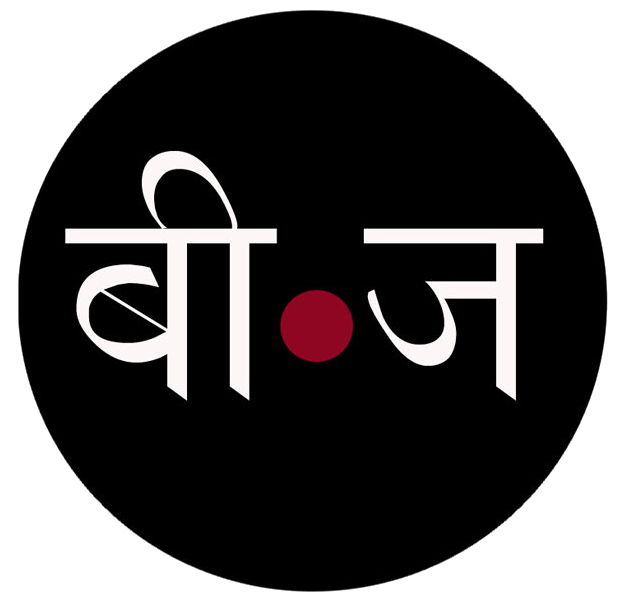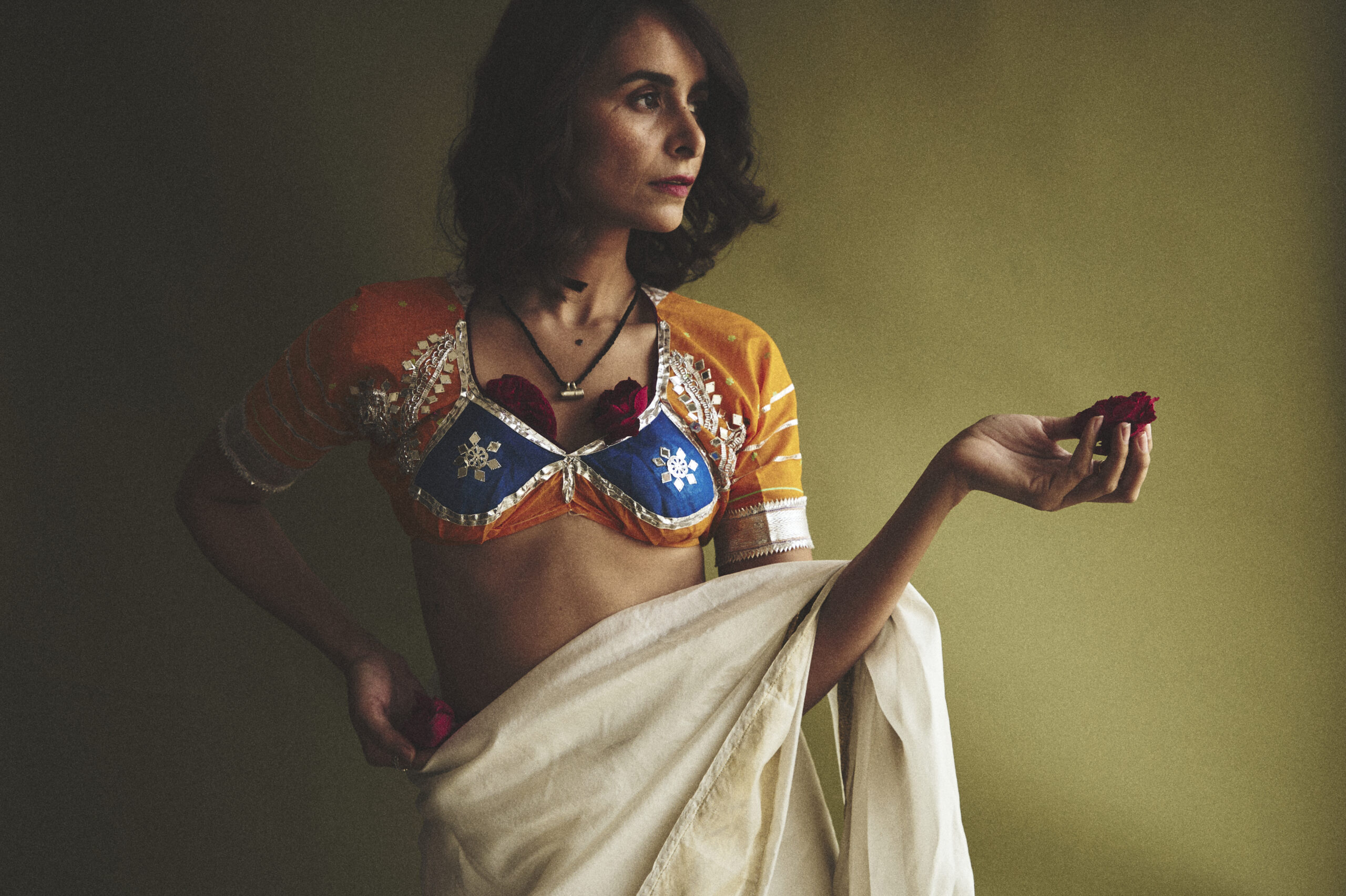Salvation in god’s city, one spoon at a time
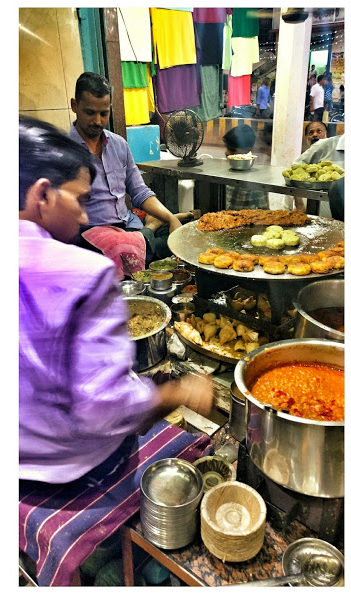
Food, like faith, is a saviour in Benaras.
It is the third time in less than three days that we have alighted at Girja Ghar Chowk, opposite to St. Thomas Church. The city’s Catholic centerpiece is the colour of a pale mango, with white stripes breaking its façade—a turreted structure with crenellations. Its cross rises above squat buildings and tangled wires that plague Varanasi. The church is an anomaly here, where most shrines pay obeisance to the matted haired, dark skinned lord. This isn’t the only landmark in the old city. Just ahead, another lofty structure is home to the Nandi Bull, the vahana of the city’s presiding deity, Shiva. The benign sculpture, perched atop a pillar, has a cascade of fairy lights strung around its base, like plump, faith-fed fireflies in the night sky.
Food, like faith, is inescapable in Varanasi. We’ve been reassured by our guide, Kunal, that no one on his food tour has suffered a belly rumble. In a land so blessed, so slow, and so random, wouldn’t food also have curried favour of the gods?
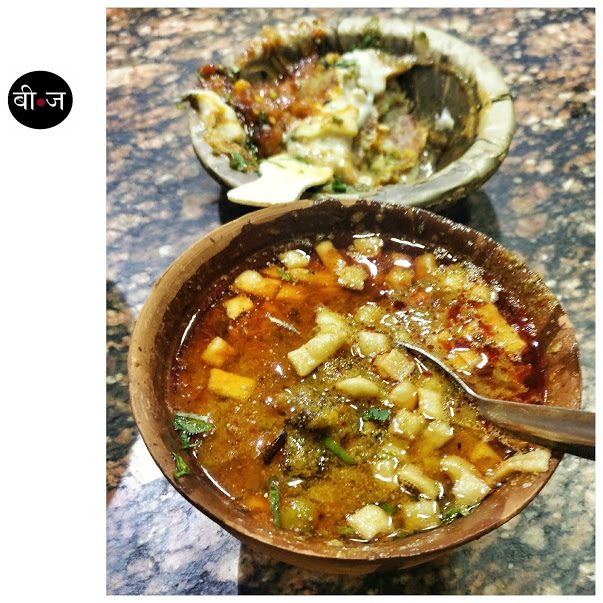
tamaatar chaat is heaven in a kullhad
At Kaashi Chaat Bhandar, a big ghada girdled in a red cloth greets us, along with a garishly coloured name board. On the other side of the roadhouse is a cut-rate store, where a curtain of garish jins-pants obscures the chaos of the city. A table fan, older than me, whirs on the counter, as aloo tikkis sizzle on the griddle. I see plump samosas, pockets of gol gappas and steel containers brimming with coriander, lime and assorted edible stuffings.
On a muddy granite coloured table, first glides out a plate of aloo tikki, drowning in yoghurt and chutneys, followed by my favourite palak chaat, similarly plunged into a dulcet swamp. We eat saffron kulfi, rich and milky, politely declining the translucent falooda that wilts in the saucer. But it’s the tamaatar chaat that’s the culinary star. Discarding the scratched steel bowls, the vinegary, viscous stew comes in a special crock. A deep glistening red, with peas and crisps floating on its luscious belly, one spoonful slowly reveals ripe tomatoes, potatoes and dollops of khoya, where dried milk has been thickened on an open flame, a big rich gob that has melted into nothingness.
In 1901, British civil servant Robert Vane Russell, designated the poncy Superintendent of Ethnography, for what was then the Central Provinces of British India, along with amateur archaeologist, Rai Bahadur Hira Lal, began compiling what was to be his magnum opus, The Castes and Tribes of the Central Provinces. Published posthumously, the tome heavily relied on Vedic literature, and churlish critics dismissed the volume as racial, and, highly anecdotal. Thumbing through the text, Russell mentions that new gods arose in Hinduism, when the Vedic Aryans gave up their pastoral lives. And one of Gods they embraced was Shiva, the all powerful mountain god and moon deity, worshipped in his beneficent form of the phallic emblem as the agent of life, and the bull, the fertiliser of the soil and provider of food.
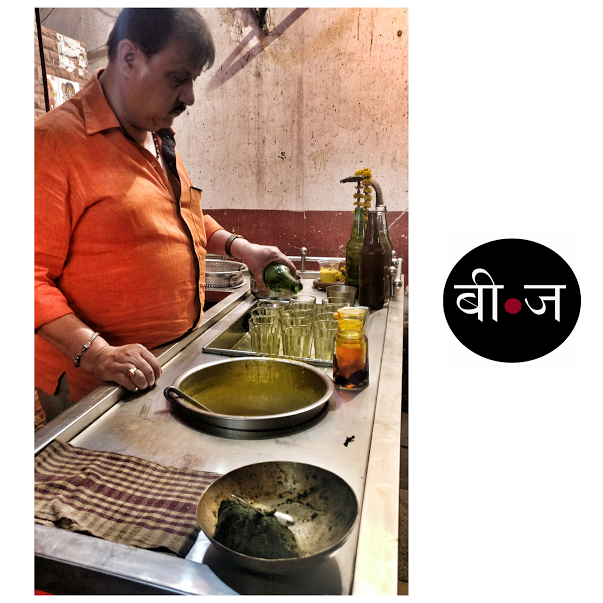
Bhaang connects you with the Gods
Varanasi’s old city is a jangle of arteries and veins, clotted with traffic that seldom moves. We move with the crowds, our steps matching with theirs. Understandably, you cannot leave without quaffing down a glass of thandai, or its intoxicating iteration, bhang. At Baba Thandai, a board with a dancing Shiva has a notable postscript: we have no branch. On the counter is a brass statue of the lord with the cobra fanning over him. A glass of bhang is placed in front of him as an offering. Sitting on the slabs of marble fitted as benches, we watch a gentleman with glazed eyes walk in, take a glass of thandai, scoop up a dollop of bhang and pop it in his mouth. Bhang is made from the crushed leaves and buds of cannabis, ground with a pestle and mortar into a fine paste. I watch fascinated, my eyes round as saucers. He glugs down the thandai and saunters off towards Priya Matching Centre, swallowed by the alleyway, into the sodium vapour glow of the night.
“To the Hindu the hemp plant is holy,” wrote J.M. Campbell, the Collector of Land Revenue and Opium, in the Indian Hemp Drugs Commission Report in 1893, “the bhang leaf is the home of the great Yogi or brooding ascetic Mahadev. In moderation bhang is the best of gifts. Bhang is a cordial, a bile absorber, an appetiser, a prolonger of life. Bhang quickens fancy, deepens thought, and Judgment. He who drinks bhang drinks Shiva. Bhang is the joy-giver, the sky-flier, the heavenly-guide, the poor man’s heaven, the soother of grief.” Indeed.
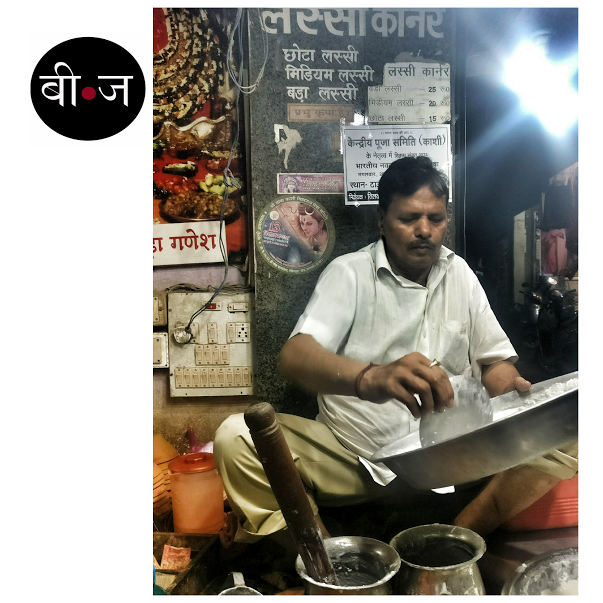
You don’t drink, but eat lassi in Benaras
It’s dusk and I’m already satiated but we stop at Lassi corner to eat through the thickened cow milk lassi, with an ice cream spoon, before halting at kesari chaat bhandar to have much of the same, with the addition of two plump, pista laden gulab jamuns that ooze with goodness in your mouth. Waddling around without a digestive was not a good idea, so we sidle up to a paanwala, who makes us a navratana paan, with the corners neatly tucked in, none of the gulukund dripping.
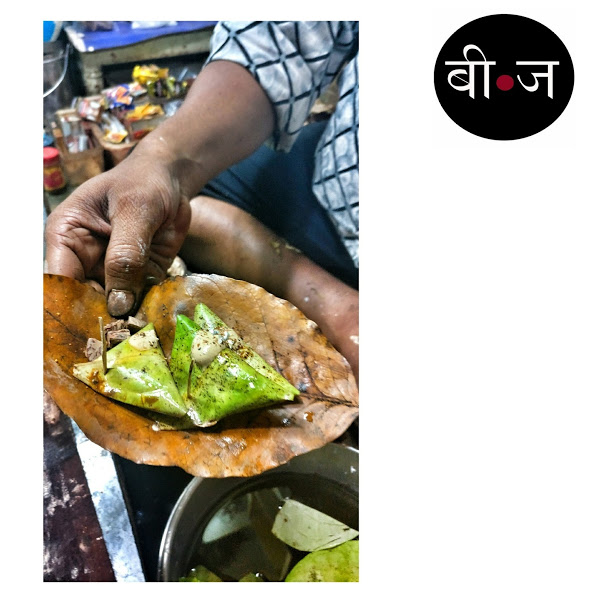
Khaike paan Benaras wala…
There is not much left to try, and after much protestation, we agree for a hot cup of tea. At Lakshmi chai wale, my hands cup a hot kulhad of sugary masala tea. Outside the dive, a strange contraption, and even a stranger preparation is being roasted on the flames. Like all other eateries, emblazoned on Lakshmi Chai Wale’s vinyl signage is the proclamation of the sole item on the menu—a very anglicised safed makhan toast. While the tea bubbles in an open pot, spluttering in an open cauldron next to it is white butter, churned and swirled into thick, smooth velvet. The toasts, 16 fitted into a wire mesh thingmajig, are being toasted over the fire, till their ends became brown and crispy, a rich honey glow spilling toward the centre. After slathering a glob of butter, coarse white sugar is sprinkled on the yeasty white bread that’s still warm and slightly charred.
This is my slice of redemption.
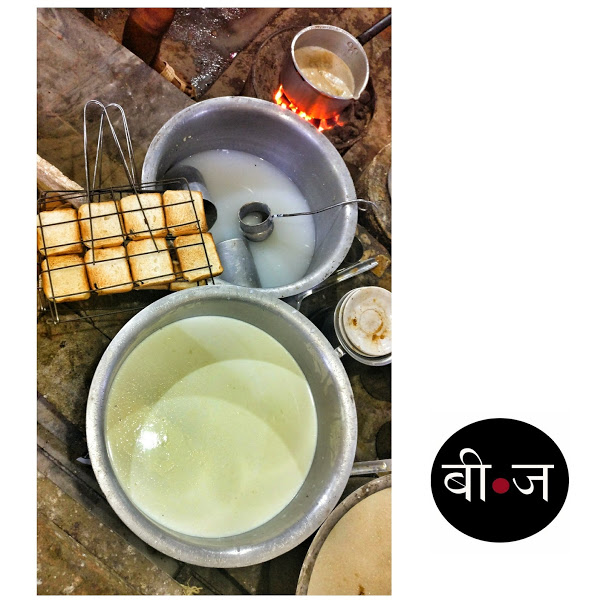
With makkhan and toast and you can never go wrong
Guide
Kaashi Chaat Bhandar: The rate card is painted in red on a mirror, so you can’t miss it. Must have are the kulfi-falooda for Rs 50, the palak chaat is for rs 30, and the tamatar chat is Rs 30.
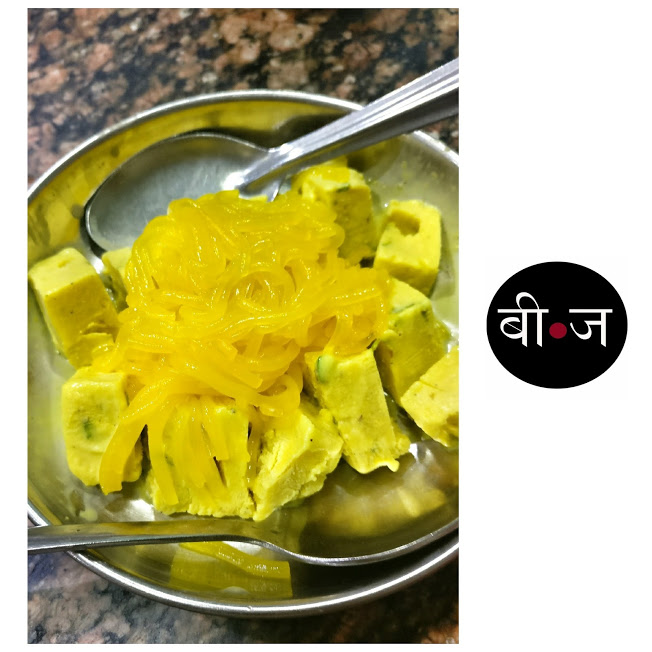
Baba Thandai: Thandai for Ra 40 and Bhaang for Rs 50. Don’t touch anything there and definitely not the bowl of bhang, like I did, because it has been offered to the lord.
Lassi Corner: It’s very simple: big (Rs 25), medium (rs 20) and small (Rs 15), served in beautiful kulhads.
Kesari Chaat Bhandar: It serves paalak chaat, gol gappas, aloo chaat, and the rest, but I recommend you try the gulab jamuns.
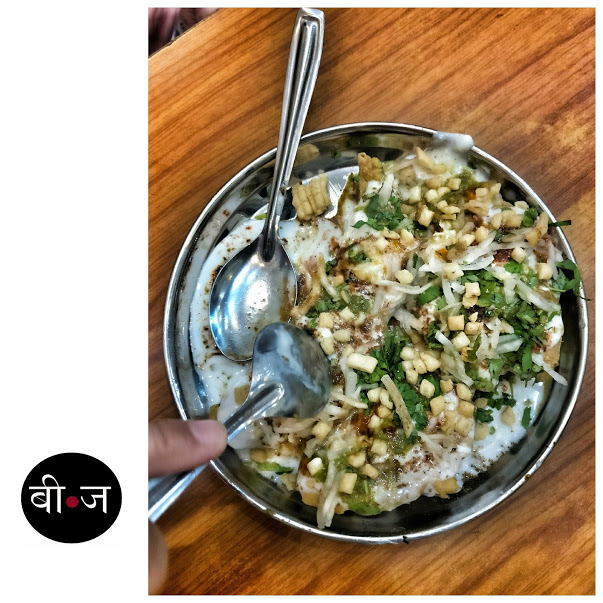
Laxmi chai wale: Try the tea, and of course, the safed makkhan toast.
Paan: Amitabh Bachchan needs to take credit for having me sold on Benarasi paan, but we ate it with much more sophistication. We chose a local street vendor who used the magai leaf. Deftly made, the gulukund paan cost only Rs. 15, while the navratan paan costs a princely Rs. 25.
Experience Varanasi tours: Kunal Rakshit and his team were very helpful, knowledgeable and made us feel at home.

